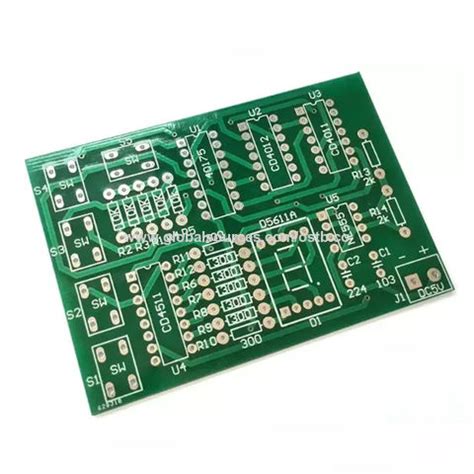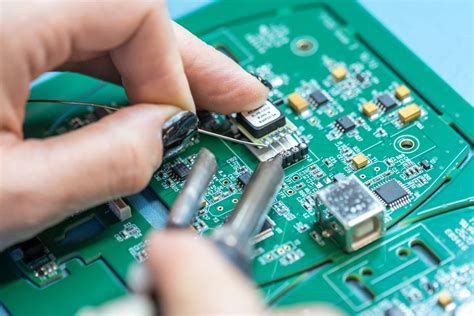Flexible pcb hersteller
Advantages Of Flexible PCB Hersteller In Modern Electronics
In the rapidly evolving landscape of modern electronics, the role of flexible PCB (Printed Circuit Board) Hersteller, or manufacturers, has become increasingly pivotal. These manufacturers specialize in producing flexible PCBs, which are essential components in a wide array of electronic devices. The advantages of flexible PCB Hersteller are manifold, contributing significantly to the advancement and efficiency of contemporary electronic products.
To begin with, flexible PCBs offer unparalleled versatility in design, which is a primary advantage provided by these manufacturers.
Unlike traditional rigid PCBs, flexible PCBs can be bent, folded, and twisted to fit into compact and irregularly shaped spaces. This adaptability is crucial in the development of modern electronics, where miniaturization and space optimization are paramount. Flexible PCB Hersteller leverage advanced manufacturing techniques to produce circuits that can conform to the intricate geometries required by cutting-edge devices, such as smartphones, wearable technology, and medical implants.
Moreover, the lightweight nature of flexible PCBs is another significant benefit.
In applications where weight is a critical factor, such as in aerospace and portable consumer electronics, the reduction in weight achieved by using flexible PCBs can lead to enhanced performance and user experience. Flexible PCB Hersteller utilize materials that not only reduce weight but also maintain the necessary durability and reliability, ensuring that the final product meets stringent industry standards.
In addition to their physical advantages, flexible PCBs also offer improved electrical performance.
The ability to design circuits with shorter interconnections reduces the potential for signal loss and electromagnetic interference, which are common issues in more complex electronic assemblies. Flexible PCB Hersteller employ sophisticated design and fabrication processes to optimize the electrical characteristics of these circuits, thereby enhancing the overall functionality and efficiency of the electronic devices they are integrated into.
Furthermore, the cost-effectiveness of flexible PCBs is a compelling advantage.
While the initial design and setup costs may be higher compared to rigid PCBs, the long-term benefits often outweigh these initial expenses. Flexible PCB Hersteller can produce circuits that consolidate multiple components into a single flexible board, reducing the need for additional connectors and interfaces. This consolidation not only lowers material costs but also simplifies assembly processes, leading to reduced labor costs and faster production times.
Another noteworthy advantage is the reliability and durability of flexible PCBs.
These circuits are designed to withstand dynamic flexing and environmental stresses, making them ideal for applications that require repeated bending or exposure to harsh conditions. Flexible PCB Hersteller employ rigorous testing and quality control measures to ensure that their products can endure the demands of various applications, from automotive to industrial electronics.
In conclusion, the advantages of flexible PCB Hersteller in modern electronics are substantial and multifaceted. Their ability to produce versatile, lightweight, and high-performance circuits plays a crucial role in the development of innovative electronic devices. As technology continues to advance, the demand for flexible PCBs is expected to grow, further highlighting the importance of these manufacturers in the electronics industry. By providing solutions that enhance design flexibility, electrical performance, cost-effectiveness, and reliability, flexible PCB Hersteller are indispensable partners in the pursuit of technological progress.

Innovative Applications Of Flexible PCBs In Various Industries
Flexible printed circuit boards (PCBs) have emerged as a transformative technology across various industries, offering a myriad of innovative applications that enhance functionality and design flexibility. As the demand for more compact, lightweight, and efficient electronic devices continues to grow, flexible PCBs have become an indispensable component in the development of cutting-edge solutions. Their unique ability to bend, fold, and conform to complex shapes allows for unprecedented design possibilities, making them a preferred choice for manufacturers seeking to push the boundaries of traditional electronics.
In the consumer electronics industry, flexible PCBs have revolutionized the design and functionality of wearable devices.
Smartwatches, fitness trackers, and other wearable gadgets benefit from the adaptability of flexible PCBs, which enable the integration of multiple components into a single, streamlined design. This not only reduces the overall size and weight of the device but also enhances its durability and comfort for the user. Moreover, the flexibility of these PCBs allows for the incorporation of advanced features such as curved displays and sensors that can conform to the contours of the human body, providing a more immersive and personalized user experience.
Transitioning to the automotive sector, flexible PCBs have found significant applications in the development of modern vehicles.
As the automotive industry shifts towards more sophisticated electronic systems, flexible PCBs play a crucial role in enabling the integration of advanced driver-assistance systems (ADAS), infotainment systems, and electric vehicle components. Their ability to withstand harsh environmental conditions, such as extreme temperatures and vibrations, makes them ideal for use in automotive applications. Furthermore, the compact nature of flexible PCBs allows for more efficient use of space within the vehicle, facilitating the design of sleeker and more aerodynamic models.
In the realm of healthcare, flexible PCBs are driving innovation in medical devices and diagnostic equipment.
The miniaturization of medical devices, such as portable monitors and implantable sensors, is made possible by the use of flexible PCBs, which offer the necessary flexibility and reliability required for such applications. These PCBs enable the development of devices that can be comfortably worn or implanted in the human body, providing continuous monitoring and real-time data collection. This has significant implications for patient care, as it allows for more accurate diagnostics and personalized treatment plans.
Moreover, the aerospace industry has also embraced the advantages of flexible PCBs, utilizing them in the design of lightweight and compact electronic systems for aircraft and spacecraft.
The ability of flexible PCBs to reduce weight without compromising performance is particularly valuable in this sector, where every gram counts. Additionally, their resistance to radiation and extreme temperatures makes them suitable for use in the harsh conditions of space, ensuring the reliability and longevity of critical systems.
In conclusion, the innovative applications of flexible PCBs across various industries underscore their importance as a key enabler of technological advancement. As manufacturers continue to explore new possibilities and push the limits of design, flexible PCBs will undoubtedly play a pivotal role in shaping the future of electronics. Their versatility, combined with their ability to meet the demands of increasingly complex and compact devices, positions them as a cornerstone of modern electronic design, driving progress and innovation across multiple sectors.

Design Considerations For Flexible PCBs: Insights From Leading Hersteller
In the rapidly evolving world of electronics, flexible printed circuit boards (PCBs) have emerged as a pivotal component, offering unparalleled versatility and adaptability. As the demand for compact and efficient electronic devices continues to rise, understanding the design considerations for flexible PCBs becomes increasingly crucial. Insights from leading hersteller, or manufacturers, provide valuable guidance in navigating the complexities of flexible PCB design.
To begin with, one of the primary considerations in designing flexible PCBs is material selection.
The choice of substrate material significantly impacts the board’s flexibility, durability, and thermal performance. Polyimide is a popular choice due to its excellent thermal stability and mechanical properties. However, depending on the specific application requirements, other materials such as polyester or liquid crystal polymer may be considered. Leading hersteller emphasize the importance of aligning material properties with the intended application to ensure optimal performance and longevity.
Moreover, the layout design of flexible PCBs requires meticulous attention to detail.
Unlike rigid PCBs, flexible circuits must accommodate bending and flexing without compromising functionality. This necessitates careful planning of trace routing and component placement. Manufacturers often recommend using curved traces instead of sharp angles to minimize stress concentration, which can lead to potential failure points. Additionally, maintaining a uniform trace width and spacing is crucial to prevent impedance mismatches and signal integrity issues.
Transitioning to the aspect of mechanical design, it is essential to consider the bend radius and flexing requirements of the PCB.
The bend radius, which is the minimum radius the board can be bent without damage, is a critical parameter. Exceeding this limit can result in mechanical failure or delamination. Therefore, designers must account for the expected bending conditions during the product’s lifecycle. Leading hersteller often provide guidelines and simulation tools to assist designers in evaluating the mechanical behavior of flexible PCBs under various conditions.
Furthermore, thermal management is another vital consideration in flexible PCB design.
Due to their compact nature, flexible circuits can be prone to heat accumulation, which can adversely affect performance and reliability. Effective thermal management strategies, such as incorporating thermal vias or using heat-dissipating materials, are essential to mitigate these risks. Manufacturers frequently collaborate with designers to develop customized solutions that address specific thermal challenges.
In addition to these technical considerations, manufacturability and cost-effectiveness are also paramount.
The complexity of flexible PCB designs can significantly impact production costs and lead times. Therefore, it is advisable to engage with experienced hersteller early in the design process to ensure that the design is optimized for manufacturability. This collaboration can help identify potential cost-saving opportunities and streamline the production process.
In conclusion, designing flexible PCBs involves a multifaceted approach that encompasses material selection, layout design, mechanical considerations, thermal management, and manufacturability. Insights from leading hersteller provide invaluable guidance in navigating these complexities, ensuring that the final product meets the desired performance and reliability standards. As the demand for flexible electronics continues to grow, staying abreast of the latest design practices and collaborating with experienced manufacturers will be key to achieving success in this dynamic field.

Future Trends In Flexible PCB Manufacturing And Technology
The landscape of flexible PCB (Printed Circuit Board) manufacturing is undergoing a significant transformation, driven by rapid technological advancements and evolving market demands. As industries increasingly seek miniaturization and enhanced functionality in electronic devices, flexible PCBs have emerged as a pivotal component, offering unparalleled versatility and adaptability. This shift is not only reshaping the manufacturing processes but also influencing the future trends in this dynamic field.
One of the most prominent trends in flexible PCB manufacturing is the integration of advanced materials.
Manufacturers are exploring innovative substrates and conductive materials that offer superior flexibility, durability, and thermal management. For instance, the use of polyimide and liquid crystal polymer substrates is gaining traction due to their excellent thermal stability and mechanical properties. These materials enable the production of thinner, lighter, and more robust PCBs, which are essential for applications in wearable technology, medical devices, and automotive electronics.
In addition to material advancements, the adoption of cutting-edge fabrication techniques is revolutionizing the production of flexible PCBs.
Additive manufacturing, or 3D printing, is emerging as a game-changer, allowing for the creation of complex geometries and customized designs with high precision. This technique not only reduces material waste but also shortens production cycles, thereby enhancing efficiency and cost-effectiveness. Moreover, laser direct structuring (LDS) is being increasingly utilized to produce intricate circuit patterns on three-dimensional surfaces, further expanding the design possibilities for flexible PCBs.
As the Internet of Things (IoT) continues to proliferate, the demand for flexible PCBs is expected to surge.
IoT devices require compact, lightweight, and flexible electronic components to accommodate their diverse applications, ranging from smart home systems to industrial automation. Flexible PCBs, with their ability to conform to various shapes and sizes, are ideally suited to meet these requirements. Consequently, manufacturers are focusing on developing PCBs with enhanced connectivity and integration capabilities to support the seamless operation of IoT ecosystems.
Furthermore, the trend towards sustainable manufacturing practices is influencing the flexible PCB industry.
Environmental concerns and regulatory pressures are prompting manufacturers to adopt eco-friendly processes and materials. This includes the use of lead-free soldering techniques, recyclable substrates, and energy-efficient production methods. By prioritizing sustainability, manufacturers not only comply with environmental standards but also appeal to environmentally conscious consumers and businesses.
Another significant trend is the increasing emphasis on reliability and performance testing.
As flexible PCBs are deployed in critical applications such as aerospace and healthcare, ensuring their reliability and performance under various conditions is paramount. Advanced testing methodologies, including thermal cycling, mechanical stress testing, and electrical performance evaluation, are being implemented to guarantee the quality and durability of flexible PCBs. This focus on rigorous testing is essential to meet the stringent requirements of high-stakes industries and to foster trust among end-users.
In conclusion, the future of flexible PCB manufacturing is characterized by a confluence of technological innovations and market-driven trends. The integration of advanced materials, adoption of novel fabrication techniques, and emphasis on sustainability and reliability are shaping the evolution of this industry. As flexible PCBs continue to play a crucial role in enabling the next generation of electronic devices, manufacturers must remain agile and forward-thinking to capitalize on emerging opportunities and address the challenges of an ever-changing technological landscape.






